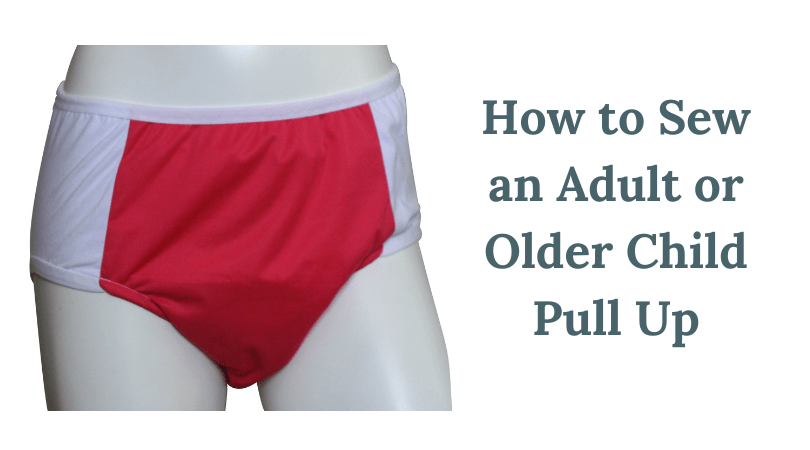Pull ups make a great option to discreetly manage incontinence. Sewing your own adult or older child pull is easy to do and will save you money in the long run on disposable incontinence products. The full panel of waterproof fabric combined with stretchy sidebands allows for full leakproof coverage while not compromising on fit and comfort.
Related content: Adult Training Pants vs. Pull Up vs. Pull On Diaper
How to Make an Adult Pull Up – Supplies
Fabric
Waterproof fabric – PUL is hands down the most durable and easiest waterproof fabric to sew. Not to mention, it’s readily available in a variety of price points.
Lining fabric – the fabric choice for the lining of the absorbent briefs again depends on your needs and preferences. Cotton is softer next to skin, but tends to feel cold and heavy when wet. A stay-dry fabric like athletic wicking mesh or microfleece can also work well and keep the skin feeling dry.
I have also made pull ups with bamboo fleece lining. So really there’s no wrong way as long as the fabric absorbs moisture and/or allows it to pass through to the absorbent core.
Absorbent fabric – Any type of absorbent fabric can be used. 3D zorb is my fabric of choice simply because it offers A LOT of absorbent capacity without bulk. But it’s expensive. You could use flannel (though it would take a lot of layers) or any absorbent material.
Stretch fabric – since pull ups are meant to pull up and down like regular underwear, choosing a soft fabric with stretch is necessary for the sidebands.
Fabrics with spandex are great – I find that they don’t pill as quickly as a cotton/poly interlock – but fabrics with a 2-way stretch across the grain also work as well. You could also use bamboo or a modal jersey. Just make sure that the stretchiest part of the fabric is going around the body.
Notions
Ballpoint, Jersey, or Stretch needles – PUL is considered a knit fabric and needs to be sewn using a ballpoint, jersey, or stretch needle. And of course, jersey and other stretch fabrics are knits as well.
Knit Elastic -These sewing instructions use ⅜” knit elastic for the legs. For an overview of elastic types, check out Seamworks’ guide.
Fold Over Elastic (FOE) – 1” FOE is a super simple and easy way to finish the waistband and sidebands. Stitch with a 3-step zigzag stitch.
Sewing Machine – while just about anything can be sewn by hand, it’s much less time intensive to use a sewing machine. All you need is a basic machine to sew an adult pull up.
Pattern – You can make your own pattern by tracing an existing item. I also have Adult Pull Up, Adult Heavy Absorbency Pull Up, Child Pull Up, and Child Heavy Absorbency patterns available for sale. These patterns also come with instructions for a side snap option, which we will not go into here.
How to Make an Adult Pull Up – Cutting Fabric
1. You will need to cut one panel from PUL and one from your lining fabric of choice.
2. Cut 4 sidebands from stretchy fabric. I always use a cotton jersey for the outside of the sideband and make the inside sidebands from the same fabric as the lining, as long as it has some stretch.
3. For the sewn in absorbent pad, cut as many layers of absorbent fabric as you want.
Finally, cut your ⅜” elastics for the legs and the 1” FOE for the waistband and sidebands to your desired length.
How to Sew an Adult Pull Up
Once you have your pieces cut out, it’s time to sew!
Step 1: Sew absorbency
If using multiple layers of fabric for the sewn-in absorbency, you first need to sew those layers together. A simple zigzag stitch around the outside of the layers is the easiest way to finish the absorbency if you don’t have a serger. Don’t worry if it looks a little messy – it’ll be completely hidden inside the garment.
If you are using a lot of layers, it can be helpful to stitch an extra line down the center through all the layers. This helps prevent the layers from shifting when washed.
Step 2:
Center absorbent pad towards the front of the pull up on the wrong side of the lining. You want to make sure to center the absorbency according to where you need it. Based on customer feedback, I have found that placing it 2-3 inches below the front waistband is ideal.
Stitch down using a straight or zigzag stitch.
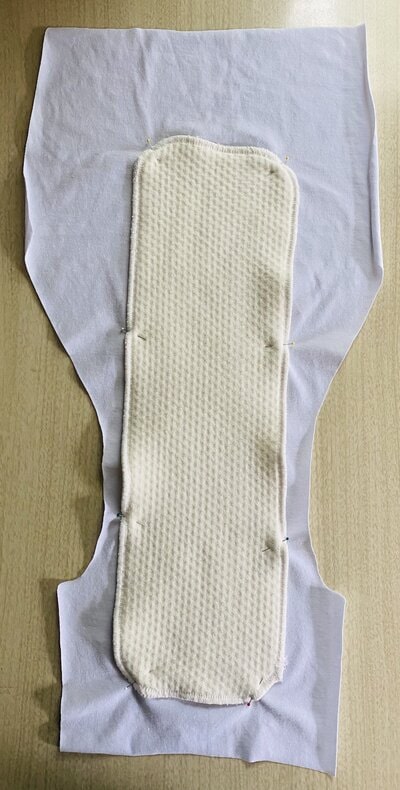
Step 3:
Lay the right sides of the outer panel and lining panel together. Pin and stitch along leg openings using straight stitch.
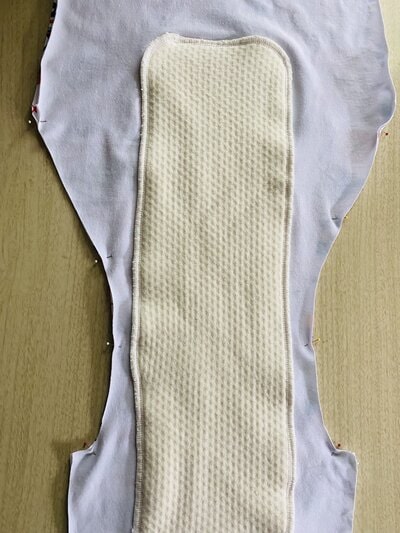
Step 4:
Lay pieces or sideband wrong sides together. Baste across the top.
Pin FOE to bottom curve of sideband and stitch using 3-step zigzag stitch.
Repeat for other sideband.
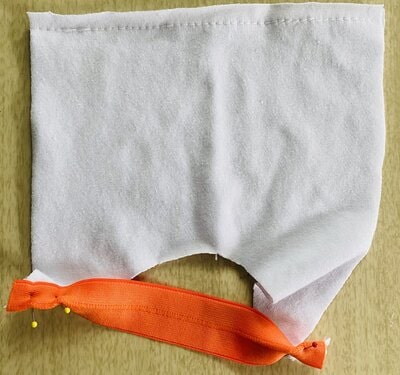
Step 5:
Pin short side of sideband to the front of the pull up between the lining and PUL. Stitch using straight stitch. Repeat on other side.
Step 6:
Zigzag stitch elastic along leg seams.
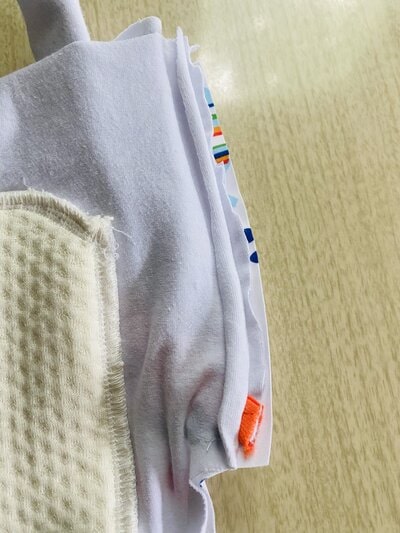
Step 7:
Pull sidebands through center of pull up and pin long side of sideband between lining and PUL on the back of pull up. Stitch.
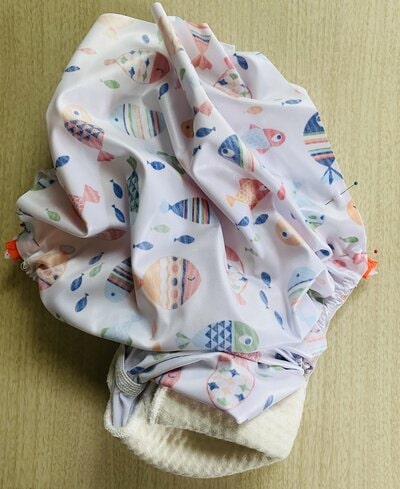
Step 8:
Turn pull up right side out.
Topstitch PUL around leg openings.
Baste along the top of the waistband. Trim any excess fabric.
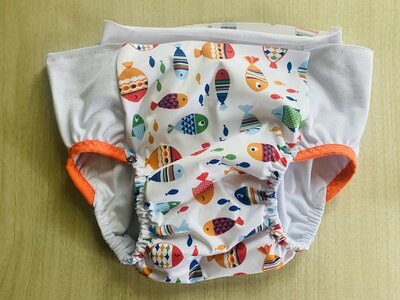
Step 9:
Sewing your FOE into a circle, mark it into quarters.
Mark the waistband in quarters.
Pin FOE to waistband at quarter markings. Using a 3 step zigzag stitch, stitch FOE to waistband, gently stretching to match the pull up waistband. Be careful not to overstretch on the sidebands.
FINISHED!
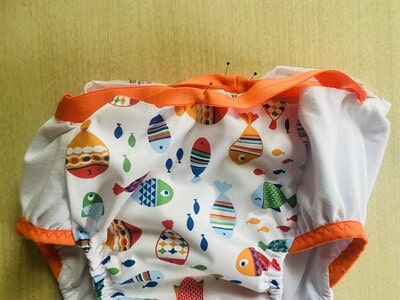
Alecia
Latest posts by Alecia (see all)
- How to Make a Cloth Diaper Bigger - August 21, 2023
- Best Swim Diapers for Adults and Youth - July 18, 2023
- Adult Cloth Diaper Hacks: How to Make a Swim Diaper - July 14, 2023

